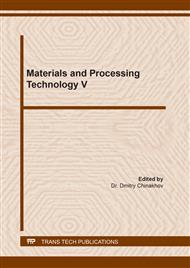[1]
Standard Specification for Chromium and Chromium-Nickel Stainless Steel Plate, Sheet, and Strip for Pressure Vessels and for General Applications / Designation: A 240/A 240M–04a. 2004. 12 p.
DOI: 10.1520/a0240_a0240m-13c
Google Scholar
[2]
Specification for chromium and chromium-nickel stainless steel plate, sheet, and strip for pressure vessels and for general applications / SA-240/SA-240M. 2007. Section II, part A. 12 p.
DOI: 10.1520/a0240_a0240m-13c
Google Scholar
[3]
http://www.goodner.ru/services/info/marks/.
Google Scholar
[4]
Ma, Y., Li, Y., & Wang, Y.F. (2009) Corrosion of low carbon steel in atmospheric environments of different chloride content, Corrosion Science, 51(5), 997–1006.
DOI: 10.1016/j.corsci.2009.02.009
Google Scholar
[5]
Li, L., Dong, C. F. Xiao, K. Yao, J. Z. & Li, X.G. (2014) Effect of pH on pitting corrosion of stainless steel welds in alkaline salt water, Construction and Building Materials, 68, 709–715.
DOI: 10.1016/j.conbuildmat.2014.06.090
Google Scholar
[6]
Burjak, T.N., Jaroshenko, N.V. Taranenko A.A. (2015) Analiz materialovedcheskih aspektov v ocenke jekspluatacionnoj nadezhnosti svarnyh trub iz korrozionnostojkoj stali dlja kondensatorov AЕS, Jaderna ta radiacijna bezpeka, 2(66), 31-38.
Google Scholar
[7]
Narivskij, A.Je., Belikov, S.B. (2006) Opredelenie pittingostojkosti stali AISI 304 v hloridsoderzhashhih sredah, kotorye prisutstvujut v rabote teploobmennikov, Fiziko-himicheskaja mehanika materialov, 6, 136–140.
Google Scholar
[8]
Ul'janin, E.A. (1991) Korrozionnostojkie stali i splavy, Metallurgija, M., 256.
Google Scholar
[9]
Solidor, N.A., Ivanov, V.P., Morgay, F.V. & Nosovsky, B.I. (2015) Investigation of corrosion resistance welds metal hose made of steels AISI 304 and AISI 316, Eastern-European Journal of Enterprise Technologies, 76(4/5), 33–39. doi: 10.15587/ 1729-4061.2015. 47035.
DOI: 10.15587/1729-4061.2015.47035
Google Scholar
[10]
Panin, S.V., Kurs, M.G. (2012) Issledovanie korrozionnoj stojkosti nerzhavejushhih stalej v uslovijah umerenno teplogo klimata, Vestnik VIAM, 7, 4–9.
Google Scholar
[11]
Tsutsumi, Y., Nishikata, A. & Tsuru, T. (2007) Pitting corrosion mechanism of Type 304 stainless steel under a droplet of chloride solutions, Corrosion Science, 49(3), 1394–1407.
DOI: 10.1016/j.corsci.2006.08.016
Google Scholar
[12]
Gojhenberg, Ju.N. (1972) Prevrashhenija pri plasticheskoj deformacii i ih vlijanie na mehanicheskie svojstva, Voprosy proizvodstva i obrabotki stali, 107, 136-145.
Google Scholar
[13]
Ivanov, V.P., Makarenko, N.A., Lavrova, E.V. & Ahieieva, M.V. (2020) Electric arc deposition of an anticorrosive layer with two strip electrodes. Solid State Phenomena, 303, 39–46. https://doi.org/10.4028/www.scientific.net/ssp.303.39.
DOI: 10.4028/www.scientific.net/ssp.303.39
Google Scholar
[14]
Ivanov, V., Lavrova, E., Morgay, F. & Semkiv, O (2021) Investigation of the heat-affected zone properties during cladding of power equipment with austenitic materials using control mechanical impacts on the strip electrode, Materials Science Forum, 1038, 100-107. https://doi.org/10.4028/www.scientific.net/MSF.1038.100.
DOI: 10.4028/www.scientific.net/msf.1038.100
Google Scholar


